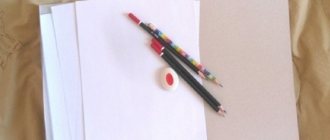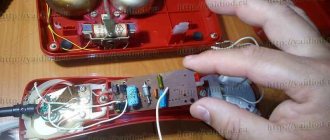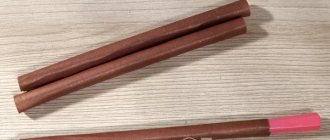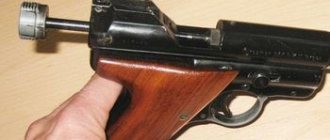We are making a simple device for viewing 3D holograms on your smartphone or tablet. Have you ever wanted to watch videos or watch pictures in 3D without glasses? In this tutorial you will learn how to make a very simple device for viewing 3D holograms on your smartphone or tablet. All you need for this is five minutes of your time. And yes, today we don’t need Arduino, Raspberry and other boards.
How does a 3D pyramid hologram work?
A holographic pyramid is a simple device that can be made by creating a pyramid-shaped shape with the top cut off from a sheet of plastic. The device creates a three-dimensional illusion for the viewer and makes the image or video appear as if it is in the air. Works on the principle of Pepper's Ghost (English Wikipedia). Four symmetrically opposite versions of the same image are projected onto the four faces of the pyramid. Basically, each side projects the image falling on it into the center of the pyramid. These projections work in unison to form an entire figure that creates a three-dimensional illusion.
Where to get ready-made images to create a hologram
Pictures for reproducing holograms should not be ordinary, but specially prepared. As described above, the image must be symmetrical within a square and consist of 4 identical elements arranged crosswise. You can make such a blank yourself and give it movement, show your artistic abilities, expressing your thoughts. Before you try to do this, you need to find ready-made animations and videos for viewing holograms. Then make a prism and acquire your first skill in creating 3D images. Remembering the principle of operation, it will be easier to realize your own ideas.
Creating a pyramid for 3D holograms
1. Print out the template shown below on a piece of A4 paper.
NOTE : If you don't have access to a printer, you can also create the template yourself. Draw a basic "trapezoid" on a piece of paper using the dimensions in the picture above. Parallel sides = 1 cm and 6 cm, the other two sides are 4.5 cm each. You can always double or triple the sizes proportionally for use on a larger display.
2. Trace the shape onto the plastic sheet using a ruler and pen. For a trapezoidal template, mark four similar outlines on a plastic sheet. Now carefully cut out the outlines with a cutting blade and a ruler. Try to make your cuts as precise as possible to create a more perfect pyramid.
3. If you used a print template: very lightly score the red edges using a cutting blade. This will allow you to better fold the edges and form a pyramid shape. Seal the open edges of the sheet together using clear tape.
If you used a trapezoidal template: Bring the four edges together to form a pyramid shape. Connect them. Either way, you will end up with a pyramid like the one shown below.
4. That's it! You have made yourself a pyramid for future holograms! All you have to do now is play the hologram on your phone. Place the hologram in the center of the screen as shown in the picture below and enjoy the show. Remember to turn off the lights in the room before you start playing the video.
5. Now the most important thing! You can find many holograms on YouTube. You can see what can happen in the video below.
What is a hologram?
Holograms are a bit like timeless photographs. These are a kind of "photographic ghosts": they look like 3D photographs that have somehow become trapped inside glass, plastic or metal. When you tilt the credit card hologram, you see an image of what appears to be a bird moving “inside” the card. How does it get there and what makes the hologram move? How is it different from regular photography?
Let's say you want to take a photo of an apple. You hold the camera in front of you, and when you press the shutter button to take a photo, the camera lens opens briefly and allows light to hit the film (in an old-fashioned camera) or the light-sensitive image sensor chip (the chip in a digital camera). All the light coming from an apple comes from one direction and hits one lens, so the camera can only record a two-dimensional picture of light, dark, and color.
The elephant hologram looks like this
If you look at an apple, something different happens. The light bounces off the surface of the apple into both of your eyes, and the brain merges them into one stereoscopic (three-dimensional) image. If you turn your head slightly, the rays of light reflected from the apple will travel along slightly different paths to meet your eyes, and parts of the apple may now appear lighter, darker, or a different color altogether. Your brain instantly recalculates everything and you see a slightly different picture. This is why the eyes see three-dimensional images.
A hologram is a cross between what happens when you take a photograph and what happens when you look at something for real. Like photography, a hologram is a permanent recording of light reflected from an object. But the hologram also looks real and three-dimensional and moves when you look around it, just like a real object. This is due to the unique way in which holograms are created.
To always keep abreast of the latest news from the world of high technology and popular science, subscribe to our news channel on Telegram.
Pyramid dimensions
The holographic pyramid has the following dimensions: the width of the upper part of the stencil is 10 mm, the lower part is 60 mm, and the height is 35 mm. It is also very important that the pyramid should be at an angle of 45 degrees. Next, attach the stencil to the glass. It needs to be temporarily glued with double-sided tape. Next, we’ll make cuts using a knife and break off the glass using pliers. First, you can clamp the workpiece in a vice.
As a result, the workpiece should look like a triangle. We process chips with sandpaper. We perform the same actions 3 more times. As a result, we should have four pieces of workpiece.
When all the blanks are ready, you need to remove the backings and glue them together with a glue gun. Our task is completed, so that we can see the illusion, we need to install it in the center on the smartphone screen. You also need to cover the pyramid with a piece of cardboard. We launch the picture and observe from any angle.
Holographic effect
Unfortunately, such an illusion cannot be called a hologram, because 2-D pictures and videos are used here
to create the desired effect.
A true hologram creates a 3-D image and uses technology that separates laser beams.
A hologram is a three-dimensional image of a three-dimensional object or 3D imaging technology. Implemented using a laser. Thanks to it, they see a real object, although it is only a three-dimensional picture. The method has been known since 1947 thanks to Dennis Gabor - for this invention he was awarded the Nobel Prize.
Despite the apparent complexity, you can make a hologram at home, in privacy in a quiet, dark room. You will also have to purchase some accessories, which are quite expensive.
To make a hologram, you cannot do without holographic accessories: professional holographic film plates (PFG-03M); red holographic laser, for example, Integraf (4mW, 650nm); holographic kit JD-4; Photo Flo wetting agent.
Among household accessories they use: a bright, hard and durable object, for example, a toy car, coins; a book that obscures the laser (its minimum size is 15 x 20 cm, necessarily hardcover); distilled water from which the solution is prepared - you need 6 liters; trays with a flat bottom (3 pieces for developer with a size of at least 8x8 cm; 3 pieces for washing with a bottom size larger than 10x12 cm); with tongs or a rubber kitchen glove (hold the holographic plate when developing).
You can't do without: a night lamp; a tray with sand (can be replaced with sugar, salt) or a mouse pad for the vibration isolation system (length must be at least 20 cm, width - 15, height - 5); cups with sugar or salt, sand, into which the laser is installed.
To work, you need a strong table, a dark room in which the floor does not creak, there are no drafts, vibrations, or noise is heard. You can use a concrete floor, for example, in a basement.
They are preparing an object from which they will make a hologram, for example, a toy car. It is placed on the table with a mat underneath (use a tray with sand). The latter reduces possible vibrations of the object to a minimum.
A laser diode is installed to the side of the object, at a distance of 30 cm from it, so that its beam completely illuminates the toy. It is secured in a clothespin, the free end of which is stuck into a cup filled with sand. The laser beam should expand horizontally, forming a shape close to an ellipse. This is done by removing the adjustment lens (if the laser has one) or by installing an optical scattering lens in the path of the beam, which, like the laser, is secured with a clothespin.
Drawing a trapezoid
After all the necessary elements have been prepared, you should begin drawing a trapezoid (stencil). To do this, take a sheet of paper and, using a ruler and pencil, draw a trapezoid with the following sides:
- bottom – 6 centimeters;
- top – 1 centimeter;
- height – 3.5 centimeters.
After finishing, take scissors and cut out the resulting trapezoid. This will be a stencil with which the walls of the future pyramid will be made.
Cut trapezoids from CD boxes (4 pieces)
This is the most labor-intensive stage of making a pyramid, requiring increased attention. The reason for the complexity is that the plastic from which the CD box is made is very fragile and can begin to crack under strong pressure.
- We disassemble the container from the disk.
- We apply the resulting stencil.
- We outline the trapezoid with a marker.
- Take a ruler and a knife.
- Place a ruler along the marker line and carefully draw a knife along it.
- Once the grooves appear, the ruler can be removed.
- Cut out the trapezoid.
- Using the pattern of the resulting trapezoid, cut out 3 more pieces. There should be 4 in total.
A little history
The hologram illusion has been around for a long time. Similar equipment has been used in theaters, parks, museums and concerts since the 19th century. The effect was called Pepper's Ghost after the scientist D.H. Pepper, who spread the phenomenon through demonstration. This was in 1862, and today the art of holograms has reached perfection. The world began to become acquainted with the phenomenon back in the 16th century, when the Neapolitan scientist Giambattista della Porta developed an illusion camera. He also wrote the work “Natural Magic”, which is the first mention of the reproduction of illusions. The scientist considered the question of how objects that are not actually there can be seen in the camera.
The Polytechnic Institute in London is a scientific institution where D.H. Pepper worked in 1862. At the same time, the inventor G. Dirks practiced the technique of appearing a ghost on stage in a play. He tried unsuccessfully to sell his idea to theaters. This required a complete overhaul of the stage, and the effect was deemed too costly. Dirks then set up a stand at the Polytechnic Institute, where Pepper observed him. The scientist had the intention to modify the method, after which the phenomenon began to be used in cinemas. So the phenomenon gained significant success, and the world learned about it in detail. D. Pepper's improvement of the phenomenon led to it receiving his name, and Dirks transferred to him all financial rights in a joint patent. People, attending various shows, allowed themselves to be deceived, since it was believed that the phenomenon was created by geniuses.
Modern Application
Modern examples today include transparent and translucent attractions in the Walt Disney parks. The world knows them as the largest implementations of this idea. Several effects are collected on a long stage. A giant 9.1 m hologram is viewed in an empty ballroom. Animated ghosts move in hidden black rooms. The most modern version is used in the Twilight Zone Tower of Terror.
The Nashville attraction uses a classic technique, allowing guests to see spirits interacting with the environment. They can be seen especially close. California also has a Halloween attraction in the Forest Mountains featuring story characters. Projecting an image onto the floor and reflecting it in glass allows a live actor to interact with the ghost, which is used in plays. The world can see the phenomenon in the Netherlands, Australia, America, museums, parks, science exhibitions and attractions. Illusion finds application in various fields:
- Television and cinema use the method to broadcast programs and create effects.
- Sometimes the phenomenon is used for commercial purposes to attract visitors.
- It is often used at music concerts. But in this case, the images are often projected rather than holographic. Entire installations run on special software.
- Political speeches allow you to reproduce figures in several places at once. This effect was used in India during the speech of Minister Narendra Modi.
- Scientific philosophy uses a holographic model of the Universe, where each part of the 3D image contains information about the whole picture. This helps to study the world in detail.
The story about creating 3D images should end with a phrase from the character Bill Cipher from the animated series Gravity Falls: “Remember that reality is an illusion, the universe is a hologram, buy gold!” This hero, drawn in the form of an all-seeing eye, according to the idea of the cartoon, appeared from the second dimension of “flat minds”. He could inhabit the mind, visit dreams and had a dark sense of humor. Hating his fellow tribesmen, he destroyed the second dimension and helped the third to manifest itself.
Optical installation
Now you know what a hologram is. How to make it at home without much expense? Many people think that this is simply impossible. However, it is not. A hologram is usually made using a special photo installation. If desired, you can also do it yourself. On the main frame it is necessary to fix a rectangular frame made of tubes with a square cross-section. Such a workpiece should be installed on a fairly strong sheet of plywood. At the same time, the structure must be stable. The object to be photographed should be placed on the additional tube.
The main part of this installation is an optical bench, the length of which is half a meter. You need to install several tripod holders on it. They will screw into the lens. The latter should be biconcave. The focal length of the lenses should be 3 centimeters. The optical bench should be painted matte black.
Source











